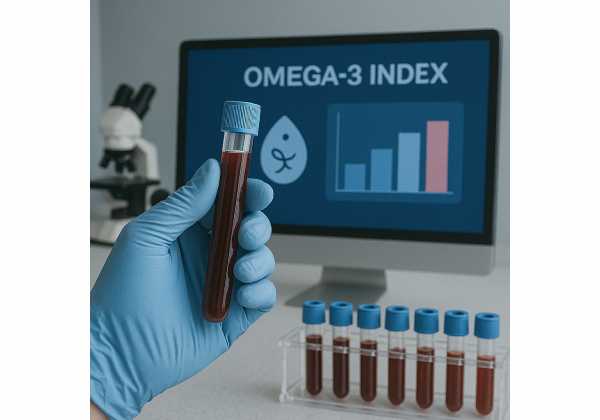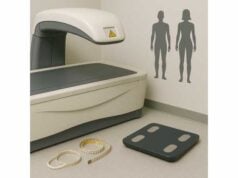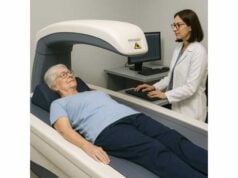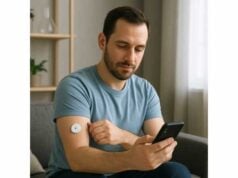
A high-functioning longevity plan looks beyond total cholesterol and basic fish-oil advice. The omega-3 index—EPA plus DHA measured in red blood cells—offers a direct, biologically grounded view of long-chain omega-3 status over the last few months. It tracks how consistently you eat fatty fish or take EPA/DHA supplements and whether those inputs actually reach tissues. Used well, it can complement lipid management, inflammation control, and cardiometabolic risk reduction. This guide explains what the omega-3 index measures, how to test, realistic target zones, and how to act on results without overhauling your life. If you’re building a structured testing plan, see our overview of longevity biomarkers and tools to place the omega-3 index alongside other essentials.
Table of Contents
- What the Omega-3 Index Measures (RBC EPA+DHA)
- How Testing Works: Kits, Labs, and Turnaround
- Target Zones and How Long Changes Take to Show
- Interpreting Results with Triglycerides and Inflammation
- Retesting Cadence: When to Check Again
- Quality and Standardization Considerations
- Questions for Your Clinician or Dietitian
What the Omega-3 Index Measures (RBC EPA+DHA)
The omega-3 index is the percentage of eicosapentaenoic acid (EPA) plus docosahexaenoic acid (DHA) in red blood cell (RBC) membranes. Because RBCs circulate for roughly three to four months, their fatty-acid makeup reflects medium-term intake and tissue incorporation, not yesterday’s salmon fillet. That time horizon is valuable for longevity planning: it smooths daily noise and captures whether your routine—dietary fish, supplements, or both—actually elevates a physiological marker linked to cardiovascular and broader health outcomes.
Why RBCs and not plasma? Plasma fatty acids swing with recent meals, fasting status, and triglyceride flux. RBC membranes turn over slowly and are less affected by short-term variation. In practice, that means fewer “false highs” after a single fish-heavy weekend and better alignment with your habitual pattern. Another advantage: the index is expressed as a percent of total RBC fatty acids, which tends to standardize across individuals regardless of absolute lipid concentrations.
What about DHA versus EPA? Both contribute to the index, yet they behave differently. DHA is enriched in neural tissues and often rises more slowly; EPA tends to respond faster to supplementation and plays an outsized role in triglyceride lowering and anti-inflammatory signaling. The index does not require a perfect EPA\:DHA ratio; it simply totals them, capturing the sum of what most of us try to raise. If you’re supplementing with EPA-only (e.g., for high triglycerides), expect a stronger EPA contribution; with fish-oil blends, both components usually climb.
Factors that can nudge your baseline include genetics (variants in fatty-acid metabolism), body size and adiposity, smoking status, and age. Still, diet remains the main driver. Regular intake of oily fish (salmon, sardines, mackerel, herring, trout) or supplemental EPA/DHA is what consistently moves the needle. Vegetarians and vegans can see the index rise with algae-derived DHA/EPA; alpha-linolenic acid (ALA) from flax or chia converts poorly and rarely pushes the index into desirable zones on its own.
A practical way to think about the number: it’s a scoreboard for tissue exposure. Two people can take the same capsule dose and land at different indices because of absorption, background diet, and adherence. The index shows the result, not the promise. That makes it especially useful when you want to personalize dose and confirm that lifestyle changes are doing what you intend.
How Testing Works: Kits, Labs, and Turnaround
You can measure the omega-3 index via two main routes: a laboratory blood draw or a finger-stick kit that collects a dried blood spot. Both aim to quantify EPA+DHA in RBCs (or a validated blood-spot proxy) as a percentage of total measured fatty acids. The process is straightforward:
- Decide on the sampling method.
- Venous draw: A phlebotomist collects a small EDTA tube. The lab isolates RBCs, prepares methyl esters, and quantifies fatty acids by gas chromatography.
- Dried blood spot (DBS): You clean a fingertip, use a sterile lancet, express a few drops onto filter paper, air-dry thoroughly, and mail it in a prepaid envelope. High-quality labs use validated conversion to RBC equivalents and correct for common pre-analytical issues (e.g., spot size, hematocrit assumptions).
- Plan timing.
Fasting isn’t required. Avoid unusual fish-oil “loading” in the days before testing if it doesn’t reflect your routine. If you’re starting or changing supplements, set expectations: results reflect the prior 8–12 weeks, not just the last few days. - Ship and track.
DBS cards must be completely dry before packing. Most kits include desiccant and a humidity indicator; follow directions exactly. Turnaround is typically 5–10 business days once the lab receives the sample. Clinical draws processed in-house can be similar. - Check the report.
You should see the omega-3 index (%) plus, ideally, individual EPA, DHA, and docosapentaenoic acid (DPA) values. Some reports include population percentiles or “zones” (e.g., ≤4% very low, 4–6% low, 6–8% moderate, ≥8% desirable). Look for a method description; best-practice reports specify the analytical platform and coefficient of variation (repeatability). - Store the baseline.
Log your diet and dose for two weeks before the test. Dose-response is personal; this mini-diary helps you interpret the number and adjust intelligently.
When comparing vendors, prioritize transparent methods, proficiency testing, and stability protocols (for heat/humidity during shipping). If your longevity plan already includes lipids, consider aligning with your next ApoB-centric lipid check so results can be reviewed together and contextualized.
Common pitfalls to avoid
- Squeezing the finger too hard during DBS (dilutes with tissue fluid).
- Mailing a damp card (fatty acids degrade with moisture).
- Assuming “more capsules” right before testing will fix a low value—it won’t reflect in RBCs for weeks.
Bottom line: choose a lab using a standardized, quality-controlled method, follow the kit carefully, and schedule testing when your intake has been stable long enough to mean something.
Target Zones and How Long Changes Take to Show
For longevity and cardiometabolic risk management, a pragmatic target for the omega-3 index is around 8% to 11%. This range sits above typical Western averages (often ~4–6%) and below levels associated with very high intakes. It’s a zone where epidemiologic analyses often observe lower risks for cardiovascular events and all-cause mortality, and where clinical safety concerns (notably bleeding or atrial arrhythmias) remain low when intake is reasonable.
How long will it take to reach your target?
Because RBCs turn over slowly, significant movement usually takes 8–12 weeks of steady intake. Early changes can appear by week 4–6, but true “new steady state” is a quarterly story. Plan around that biology: test, adjust, and retest after a full quarter rather than reacting to week-to-week fluctuations.
How much EPA+DHA moves the needle?
Dose–response varies by body size, baseline index, and form (ethyl ester vs triglyceride, with meals vs fasting). As a planning anchor:
- Moving an index from ~5.4% to 8% often requires ~1,000 mg/day EPA+DHA.
- From a lower baseline (around 3.5%) to 8% may need ~1,600 mg/day EPA+DHA.
You can achieve these with two oily-fish meals weekly plus a modest supplement or with supplements alone. If you prefer diet-first, aim for 2–3 servings/week of high-EPA/DHA fish (e.g., salmon, sardines, mackerel, herring, trout). For plant-based eaters, algae-derived DHA/EPA can raise the index; ALA sources (flax, chia) help health broadly but rarely lift the omega-3 index enough by themselves.
Practical targeting by starting point
- ≤4% (very low): Start with 1,500–2,000 mg/day EPA+DHA for 12 weeks; recheck.
- 4–6% (low): Try 1,000–1,500 mg/day for 12 weeks; recheck.
- 6–8% (moderate): Add one extra fish meal weekly or 500–1,000 mg/day; recheck.
- ≥8% (desirable): Maintain current intake; confirm annually.
These are planning ranges, not prescriptions. Always adjust for your context: medications (particularly anticoagulants), body weight, and how much oily fish you actually eat.
Why aim for a zone, not a single number?
Analytical variability (typically a few percent) and biological variance (short-term dietary swings, illness, weight change) make tight control unrealistic. A zone lets you focus on durable habits rather than chasing decimal points.
If you already think in terms of quarter-scale biomarkers, the index behaves like hemoglobin A1c in timing: inputs today show up over months. For background on that cadence, see our notes on A1c timelines.
Interpreting Results with Triglycerides and Inflammation
The omega-3 index is most useful when you read it alongside other markers that capture atherogenic particles, triglyceride metabolism, and inflammatory tone.
Pair with triglycerides (TG).
EPA/DHA intake typically lowers fasting TG by a dose-dependent amount—often modest at 500–1,000 mg/day and larger at prescription-level doses. If your TG are elevated (≥150 mg/dL), an index below target may help explain the metabolic picture; raising the index through diet or supplements can be part of a triglyceride strategy. Conversely, if TG are high despite a high index, investigate alcohol, simple carbohydrates, hypothyroidism, medications, and genetic dyslipidemias.
Pair with ApoB and non-HDL-C.
ApoB counts atherogenic particles; non-HDL-C approximates the same. The omega-3 index is complementary—it doesn’t replace ApoB and does not guarantee low particle burden. For longevity, prioritize ApoB control as your primary lipid goal; use the index to optimize the anti-inflammatory and triglyceride-lowering benefits of long-chain omega-3s without losing sight of ApoB targets.
Pair with inflammation (hs-CRP).
Higher EPA/DHA status often aligns with lower low-grade inflammation, but relationships can be subtle. If hs-CRP is high and the index is low, raising omega-3 status is reasonable along with sleep, weight management, and activity. If hs-CRP remains elevated despite a high index, look for other drivers: periodontal disease, visceral adiposity, autoimmune conditions, or under-recovered training. For context on interpreting inflammatory patterns, review our concise guide to hs-CRP and related markers.
Reading complex cases
- High index, high TG: Look for excess refined carbohydrates, fructose, or alcohol; consider hypothyroidism or medications (e.g., certain estrogens).
- Low index, normal ApoB: Consider longevity beyond particles—brain health, arrhythmia risk modulation, and systemic resilience may still benefit from moving into the target zone.
- High index, elevated ApoB: Stay focused on ApoB reduction (dietary pattern, weight loss, medications if needed). Omega-3s don’t fix LDL-particle overproduction.
Safety context
At reasonable intakes (diet or typical supplement doses), bleeding risk is low; arrhythmia signals appear mainly with high-dose pharmacologic regimens and in specific populations. As with all risk/benefit decisions, match dose to the goal and monitor.
Actionable summary
Use the omega-3 index to verify that your intake is doing its job. Then integrate the result with triglycerides, ApoB, and hs-CRP to make proportionate, targeted adjustments.
Retesting Cadence: When to Check Again
Think in quarters. Because RBCs integrate exposure over months, retest about 3–4 months after any meaningful change—starting a supplement, changing dose, switching formulations, or reworking your diet. That retest shows the new steady state and lets you calibrate without guessing.
A sensible cadence:
- Building phase: test at baseline → adjust → retest at 12 weeks.
- Maintenance phase: if you’re in the 8–11% zone with stable habits and health, retest annually.
- Higher-risk or changing contexts: consider every 6 months if you’re undergoing significant weight loss, changing lipid or anticoagulant therapy, managing hypertriglyceridemia, or navigating pregnancy/postpartum (with clinician guidance).
What if results plateau below target?
- Confirm adherence (missed doses explain more plateaus than absorption).
- Take supplements with a fat-containing meal to aid absorption.
- Consider form: re-evaluate ethyl ester vs re-esterified triglyceride vs phospholipid formulations.
- Re-check body weight; larger individuals often require higher absolute doses to reach the same index.
- Review competing fats: very high omega-6 intake may modestly dampen incorporation, though dose and consistency of EPA/DHA still dominate.
Budgeting and convenience
If testing costs are a concern, use a two-step approach: build intake for 12 weeks based on a reasonable estimate (e.g., 1,000–1,500 mg/day if starting from low), then test once to confirm. If you land within 8–11%, you can transition to annual checks. If not, titrate and recheck.
Align with other labs
Bundle your retest with lipid management and metabolic checkpoints for efficient review—ApoB, non-HDL-C, fasting TG, and, if relevant, fasting glucose/insulin. Coordinating these gives you a coherent picture rather than isolated numbers. For a quick refresher on why ApoB remains the anchor, see ApoB tracking.
When to test sooner
If you change dose substantially (e.g., double intake), an interim check at 8 weeks can confirm directionality, but plan for the 12-week mark to make final dose decisions.
Bottom line: test with purpose, not out of habit. Each measurement should answer a specific question—“Did this change move me into the target zone?”—and inform your next step.
Quality and Standardization Considerations
Not all omega-3 tests are created equal. Two labs can analyze the same sample and report different numbers if their methods, calibration, or fraction measured differ. To make your results comparable over time—and meaningful in clinical conversations—look for these quality markers:
1) Defined fraction and metric
Reports should specify that the omega-3 index is EPA+DHA in RBCs as a percent of total identified fatty acids. Some labs report percentages in plasma or phospholipids, which are not interchangeable with RBCs. If your report uses a non-RBC fraction, ask whether they provide a validated conversion to RBC equivalents. For decision-making tied to published risk zones, stick with RBC-based values when possible.
2) Standardized analytical method
High-quality assays describe their sample prep (transesterification), chromatographic platform (usually gas chromatography), and repeatability (coefficient of variation). A total imprecision around the low single-digit percent range is a reasonable benchmark for confidence in small changes over time. Method standardization also matters for population comparisons and clinical “zones”; mixing methods can shift cut-points and misclassify risk.
3) Pre-analytical controls
For dried blood spots: explicit instructions on drying time, desiccant use, humidity control, and acceptable shipping windows. For venous samples: storage at the appropriate temperature and processing within defined times. These practical steps protect samples from oxidation and ensure that any change you see is biological, not an artifact.
4) Transparent reference ranges
Descriptive categories (very low/low/moderate/desirable) should state their provenance—e.g., developed from large datasets, consistent with epidemiologic thresholds. If a lab applies RBC “zones” to non-RBC methods, interpret cautiously.
5) Consistency across time
Switching vendors mid-journey can introduce noise bigger than the biological change you’re trying to detect. If you must switch, consider a split-sample (send the same sample to both labs) to establish a conversion offset, then interpret with that context.
6) Data privacy and access
Kits should provide clear information on data handling and whether de-identified results are used in aggregated research datasets. Ask for downloadable reports so you can maintain your own longitudinal file.
Putting it together
Quality signals—RBC fraction, standardized method, tight imprecision, strong pre-analytics—let you treat the omega-3 index like any serious biomarker. With that foundation, modest month-to-month changes become interpretable, and your quarterly retests map to real physiology rather than lab variability.
Questions for Your Clinician or Dietitian
A good discussion turns a single number into a plan. Bring these focused prompts to your next visit:
- Targeting: “Given my age, lipid profile, and risk factors, is an omega-3 index of 8–11% a sensible goal for me?”
- Integration: “How should we weigh my index alongside ApoB, non-HDL-C, triglycerides, and hs-CRP when choosing diet or medications?”
- Dosing: “If my index is X%, what daily EPA+DHA dose (from fish versus supplements) would you recommend for 12 weeks to reach the target zone?”
- Form and timing: “Should I prefer triglyceride-form or ethyl-ester supplements, and should I take them with meals for better absorption?”
- Safety: “Do my medications—especially anticoagulants, antiplatelets, or antiarrhythmics—change how we dose or monitor?”
- Specific goals: “If my priority is triglyceride reduction, how do we balance prescription options, diet, and omega-3 intake?”
- Dietary pattern: “Which fish species and portion sizes will reliably deliver 1,000–1,600 mg/day EPA+DHA across a typical week?”
- Longevity context: “Beyond cardiovascular outcomes, how should we think about cognitive, ocular, or musculoskeletal implications as we set a long-term index target?”
- Cadence: “Assuming I maintain the same intake, do we retest yearly, or sooner if my weight, medications, or health status change?”
- Quality assurance: “Is our laboratory method RBC-based and standardized, and will we keep using the same method for comparability?”
These questions keep the conversation grounded in your goals, not just a lab printout. They also set the tone for iterative, data-driven adjustments—test, adapt, and retest at meaningful intervals.
References
- Blood n-3 fatty acid levels and total and cause-specific mortality from 17 prospective studies 2021 (Prospective cohorts)
- Omega-3 Blood Levels and Stroke Risk: A Pooled and Harmonized Analysis of 183,291 Participants from 29 Prospective Studies 2024 (Pooled Prospective Analysis)
- Omega-3 fatty acids in heart disease—why accurately measured levels matter 2023 (Review/Guidance)
- Red Blood Cell Fatty Acid Patterns from 7 countries: Focus on the Omega-3 Index 2022 (Method/Population Data)
- Recent studies confirm the utility of the omega-3 index 2025 (Review)
Disclaimer
This article provides general information for educational purposes and is not a substitute for personalized medical advice, diagnosis, or treatment. Always discuss testing, targets, and dosing with a qualified clinician who knows your history, medications, and risk profile.
If you found this helpful, please consider sharing it on Facebook, X (formerly Twitter), or your preferred platform, and follow us for future updates. Your support helps us continue producing clear, evidence-based guides for healthy longevity.










